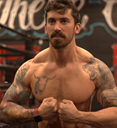Randy Couture, six-time UFC Champion, Part Of New Ownership Team
Las Vegas – After more than a decade providing athletes with the most powerful sports supplements in the world, Inner Armour Sports Nutrition is ready to step into the ring with a new ownership team that includes six-time UFC champion Randy Couture.
Launched in 2005, Inner Armour was the first global sports nutrition brand to produce products that were Banned Substance Free and included the Informed Choice and Test Sports Academy logos. These programs certified that all of their nutritional supplements were tested for banned substances by LGC Group, a global leader in pharmaceutical testing.
Using clinically tested ingredients and formulated doses, our products are trusted by both amateur and professional athletes around the world to build lean muscle mass in order to perform at the highest levels. Unlike other supplement companies that cut corners, use unsafe ingredients, or spike their supplements with banned ingredients, Inner Armour develops each product with pure, high quality and clinically researched ingredients.
IA Distribution Ltd. is the new global license owner of the Inner Armour brand and looks forward to growth by tapping into Couture’s UFC connections and expanding its product distribution within the MMA, WAKO Kickboxing, Test Football Academy, wrestling, amateur sports and the fitness enthusiast community.
The new ownership team also includes several industry heavy weights, including Kevin Mcisaac, with over 25 years’ experience in the sports nutrition industry, Jennifer Kelly, with more than 20 years’ experience with international marketing, and Paul Dhemi, who has extensive sales experience in the sports nutrition industry in the United States.
Quick Facts:
- Inner Armour Sports Nutrition will now be sold by IA Distribution Ltd.
- First sports nutrition brand to produce products that use ingredients that are Formulated Banned Substance Free.
- Used by amateur and professional athletes to build lean muscle mass in order to perform at the highest levels.
- IA Distribution Ltd. and affiliated companies own and operate certified GMP licensed facilities in North America with established manufacturing, and a distribution facility onthe East and West coast.
- IA Distribution Ltd. is excited about its combined expertise in marketing, retail, ecommerce, distribution, manufacturing, Amazon online retailing and this full skill integration will be able to provide the best product possible from concept to theconsumer’s hands.
- IA Distribution Ltd. looks forward to expanding their international partnerships that Inner Armour leadership was so key in establishing during the previous two decades.
For more information contact:
Kevin Mcisaac – Chief Executive Officer
IA Distribution Ltd. (dba Inner Armour Sports Nutrition)
1-800-950-8999
About Inner Armour Sports Nutrition
Inner Armour Sports Nutrition has been producing high-quality nutritional supplements for athletes since 2005. Inner Armour products are trusted by both amateur and professional athletes around the world to build lean muscle mass in order to perform at the highest levels.

